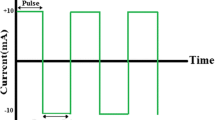Abstract
Polyaniline nanotubes (PANI-T) and graphene oxide (GO) have been compounded by a postcomposition method with the assistance of electrostatic adsorption. Using this so-called postcomposition method, both the electric double-layer capacitance of the GO and the pseudocapacitance of the conducting polymer can be utilized. PANI-T prepared by a rapid mixing method was positively charged by pretreatment with (3-aminopropyl)triethoxysilane (APTES). PANI/GO composites were obtained by mixing the positively charged PANI-T and negatively charge GO with the assistance of electrostatic attraction. Charge–discharge measurements in 1 mol L−1 H2SO4 aqueous electrolyte revealed that the specific capacitance of PANI-T/GO-10% could reach 1220 F g−1 at a current density of 0.5 A g−1, being much higher than the value of 648 F g−1 for PANI-T. After 500 cycles of charge–discharge testing, the composite retained 97% of its capacitance. These enhanced supercapacitive properties can be attributed to the two types of energy storage mechanism and the electrostatic interaction between GO and PANI-T. Preparation of such PANI-T/GO composite electrode materials by electrostatic adsorption thus provides an efficient approach for improvement of the supercapacitive properties of conducting polymers or metal oxides.
Similar content being viewed by others
References
L. Yang, B.N. Gu, and W.Q. Yang, ACS Appl. Mater. Interfaces 11, 30360 (2019).
S.X. Xiong, N.N. Yang, and J. Chu, J. Electron. Mater. 48, 6666 (2019).
W. Fan, Y.E. Miao, and T.X. Liu, RSC Adv. 5, 9228 (2015).
P.D. More, P.R. Jadhav, and A.A. Ghanwat, Mater. Electron. 28, 17839 (2017).
S.X. Xiong, Y. He, and X.K. Zhang, Biomass Convers. Biorefinery (2019). https://doi.org/10.1007/s13399-019-00525-y.
D. Nam, Y. Heo, and S. Cheong, Appl. Surf. Sci. 440, 730 (2018).
K.Z. Htut, M. Kim, and E. Lee, Synth. Met. 227, 61 (2017).
X.M. Wu and M. Lian, J. Power Sources 362, 184 (2017).
L.L. Zhang and X.S. Zhao, Chem. Soc. Rev. 38, 2520 (2009).
B.E. Conway, V. Birss, and J. Wojtowicz, J. Power Sources 66, 1 (2019).
J.P. Zheng and T.R. Jow, J. Power Sources 62, 155 (1996).
J.J. Lin, S. Yan, X.J. Zhang, and Y.R. Liu, NANO 14, 1950049 (2019).
N. Arsalani, A.G. Tabrizi, and L.S. Ghadimi, Mater. Electron. 29, 6077 (2018).
S.X. Xiong, F. Yang, and H. Jiang, Electrochim. Acta 85, 235 (2012).
L. Tang, Z.K. Yang, and F. Duan, Mater. Electron. 28, 15804 (2017).
X.T. Sun, N. Hui, and X.L. Luo, Microchim. Acta 184, 889 (2017).
B.T. DiTullio, C.J. Wright, and P. Hayes, Colloid Polym. Sci. 296, 637 (2019).
Y. Wang, X.M. Wu, and W.Z. Zhang, Mater. Chem. Phys. 209, 23 (2018).
S.X. Xiong, Y. Zhang, and Y.Y. Wang, High Perform. Polym. (2019). https://doi.org/10.1177/0954008319890644.
K.C. Xia, G.X. Wang, and H.L. Zhang, J. Nanoparticle Res. 19, 254 (2017).
K. Zhan, T. Yin, and Y. Xue, Front. Mater. Sci. 12, 273 (2018).
S. Mondal, U. Rana, and S. Malik, J. Phys. Chem. C 121, 7573 (2017).
E.A. Jafari, M. Moradi, and S. Borhani, Phys. E 99, 16 (2018).
N.L. Chen, Y.P. Ren, and P.P. Kong, Appl. Surf. Sci. 392, 71 (2017).
A.G. Tabrizi, N. Arsalani, and A. Mohammadi, Electrochim. Acta 265, 379 (2018).
Z.M. Sen, W.Z. Kai, and D.Q. Feng, Adv. Mater. Res. 476, 1446 (2012).
Y.H. Jin and M.Q. Ji, Colloids Surf. A: Physicochem. Eng. Asp. 464, 17 (2015).
Q.Q. Zhang, Y. Li, and W. Feng, Electrochim. Acta 90, 95 (2013).
D.W. Wang, F. Li, and J. Zhao, ACS Nano 3, 1745 (2009).
R. Kakarla, C. Byung, and S. Kwang, Synth. Met. 10, 1934 (2009).
N. Li, J.X. Xu, and L.J. Xu, J. Nanosci. Nanotechnol. 7, 4961 (2015).
X. Wang and P.S. Lee, J. Mater. Res. 30, 1 (2015).
L.P. Zheng, X.Y. Wang, and H.F. An, J. Solid State Electrochem. 15, 675 (2011).
H.R. Naderi, P. Norouzi, and M.R. Ganjali, Appl. Surf. Sci. 366, 533 (2016).
M.M. Yang, B. Cheng, and H.H. Song, Electrochim. Acta 55, 7021 (2010).
S.P. Zhou, H.M. Zhang, and Q. Zhao, Carbon 52, 440 (2013).
N.R. Chiou, L.J. Lee, and A.J. Epstein, Chem. Mater. 19, 3589 (2007).
P. Pavlí, K. Lenka, and N. Lucie, Chem. Pap. 71, 379 (2017).
Y. Liu, R.G. Deng, and Z. Wang, J. Mater. Chem. 22, 13619 (2012).
D.Y. Gui, C.L. Liu, and F.Y. Chen, Appl. Surf. Sci. 307, 172 (2014).
L.Y. Li and Y.Y. Zheng, High Perform. Polym. 1 (2016).
L. Mao, K. Zhang, and J.S. Wu, J. Mater. Chem. 22, 80 (2012).
Z. Gao, W.L. Yang, and J. Wang, Energy Fuels 27, 568 (2013).
S. Liu, X.H. Liu, and Z.P. Li, New J. Chem. 35, 369 (2011).
H.L. Wang, Q.L. Hao, and X.J. Yang, ACS Appl. Mater. Interfaces 2, 821 (2010).
P. Shreyasi and K.C. Kalyan, Mater. Today: Proc. 5, 9776 (2018).
Acknowledgments
This work was supported by Opening Project of Guangxi Key Laboratory of Calcium Carbonate Resources Comprehensive Utilization (HZXYKFKT201804), The Youth Innovation Team of Shaanxi Universities, Coal Washing & Preparation Center, Ningxia Coal Industry co., Ltd, CHN ENERGY, and Peak Plan of Xi’an University of Science and Technology. Natural Science Foundation of Shaanxi Province, China (Grant No. 2018JM5027).
Author information
Authors and Affiliations
Corresponding author
Additional information
Publisher’s Note
Springer Nature remains neutral with regard to jurisdictional claims in published maps and institutional affiliations.
Rights and permissions
About this article
Cite this article
Zhang, Y., Xiong, S., Wang, Y. et al. Postcomposition Preparation and Supercapacitive Properties of Polyaniline Nanotube/Graphene Oxide Composites with Interfacial Electrostatic Interaction. J. Electron. Mater. 49, 4076–4084 (2020). https://doi.org/10.1007/s11664-020-08128-4
Received:
Accepted:
Published:
Issue Date:
DOI: https://doi.org/10.1007/s11664-020-08128-4




